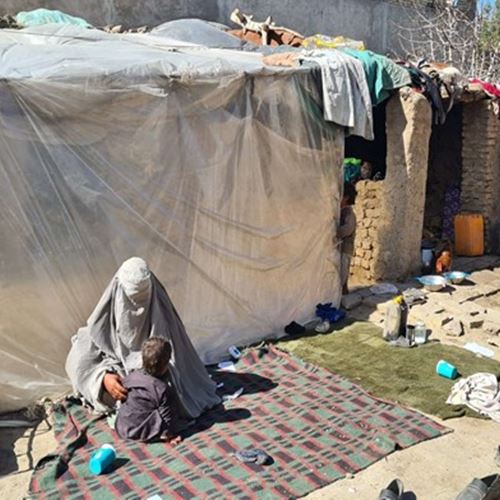Not long after her husband was killed in mid-2021, Rahima*, a 35-year-old Afghan woman and mother of nine, left her home in Arghandab, a war-torn district of Kandahar in the South of Afghanistan. She was expecting a child when her husband died during armed conflict. Now, with a newborn baby, it was no longer safe for her to remain there as a widowed woman, with the children now fatherless and without any means to feed the family of 10 people.
The youngest of her children was only eight months old when she decided to pack up their few belongings and leave Arghandab. Rahima was certain that moving would be the only way to protect the family from immediate security threats, but their new situation brought on a different kind of suffering.
A shelter, but no roof
For 2,000 Afghani a month, around USD 21, she rented a small space as their interim home in Kandahar city. It was a makeshift shelter without proper walls, windows, a door, or even a roof over their heads. This was all she could afford, but like many vulnerable people, displaced and on the move and caught in poverty, the family had no choice than to accept the interim living conditions, which left the mother worried about the safety and survival of her children.
Aid to address individual needs
DRC works in 19 of Afghanistan’s 34 provinces, including in Kandahar where emergency aid is provided to help some of the most acutely vulnerable people –like Rahima and her family. Responses are provided depending on individual and specific needs either through community-based protection initiatives targeting primarily women and girls, or in the form of multipurpose cash assistance, and lastly, through complementary referrals to partners offering additional services.
For Rahima, it meant that she was able to purchase materials to improve her makeshift home and enhance the interim shelter with a plastic tarp to protect her family and their few belongings. They could build a safe latrine and not be forced to use a public, open area. Rahima also bought a small water tank, which they now use to store water near the latrine to wash their hands. The cistern only needs to be filled once a week, so the children are no longer required to walk long distances every day to fetch water.
Due to lack of health facilities in the area, the emergency cash grant was also used to cover the transport cost for her son to travel to a health service provider in another location as well as medicine expenses. There are slow but steady improvements in his mental health, she tells. While their situation remains difficult and their future uncertain, the assistance provided by DRC have allowed Rahima to prioritise the family’s immediate and life-saving needs, and to decide how to improve their safety and wellbeing.
DRC’s emergency aid to displaced in Kandahar is made possible through funds from the Afghanistan Humanitarian Fund. Similar projects are implemented in Afghanistan’s Central Region (Ghazni, Kapisa, Maidan Wardak, Parwan), the Western Region (Herat and Farah) and in the Southern Region (Kandahar).
*Name changed
